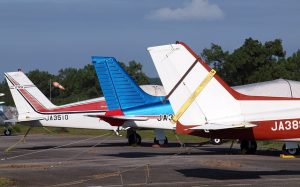
Tailplanes play an important role in modern-day aviation. Also known as horizontal stabilizers, they are lifting surfaces located on the tail of an airplane. Airplanes, of course, rely on more than just their wings to generate lift; they feature other lifting surfaces, such as tailplanes. Here are six interesting facts about tailplanes.
#1) Provides Stability
Tailplanes provide stability. They help stabilize airplanes, which is why they are also known as horizontal stabilizers. Most tailplanes consist of two horizontal flaps: one on each side of the tail empennage. Air will flow under these flaps, thus generating lift while simultaneously stabilizing the airplane.
#2) Adjustable
Unlike the wings on a typical airplane, tailplanes are adjustable. They can be adjusted via trimming to improve the airplane’s performance in flight. The angle at which a tailplane points is the trim. To counter imbalances created by weight distribution or aerodynamic forces, pilots can trim the airplane’s tailplane.
#3) Cruciform vs T-Tail
Most tailplanes fall under one of two categories: cruciform or T-tail. They both feature flap-like horizontal stabilizers, and they are both used to generate lift and improve stability. The difference between cruciform and T-tail tailplanes lies in their shape. Cruciform tailplanes consist of a cruciform shape, whereas T-tail tailplanes consist of a T-shaped design.
#4) Made of Aluminum Alloy or Composite
Different tailplanes are made of different materials. Some of the most common materials used in their construction are aluminum alloy and composite. Aluminum alloy is a lightweight, corrosion-resistant material. Composite is a strong, durable material that’s also lightweight and corrosion resistant.
#5) There Are Tailless Airplanes
Not all airplanes have a tailplane. There are some airplanes that are designed without tailplane. Known as tailless airplanes, the only aerodynamic surface they feature is the main body.
#6) The Canard Design
Some of the earliest known uses of tailplanes can be traced back to the Wright Brothers. The Wright Brothers developed a unique type of tailplane called the “Canard” tailplane. Rather than being located on the tail, the Canard was located at the front of the airplane The Wright Brothers later switched to a more conventional rear-mounted tailplane.
In Conclusion
Tailplanes are a critical aspect of airplane design. They contribute to flight stability, control, safety and overall performance. Even the Wright Brothers used tailplanes in their airplanes. As previously mentioned, they developed the Canard tailplane before transitioning to a more conventional rear-mounted tailplane found in modern-day airplanes.
- SEO Powered Content & PR Distribution. Get Amplified Today.
- PlatoData.Network Vertical Generative Ai. Empower Yourself. Access Here.
- PlatoAiStream. Web3 Intelligence. Knowledge Amplified. Access Here.
- PlatoESG. Automotive / EVs, Carbon, CleanTech, Energy, Environment, Solar, Waste Management. Access Here.
- BlockOffsets. Modernizing Environmental Offset Ownership. Access Here.
- Source: https://monroeaerospace.com/blog/6-interesting-facts-about-tailplanes/



